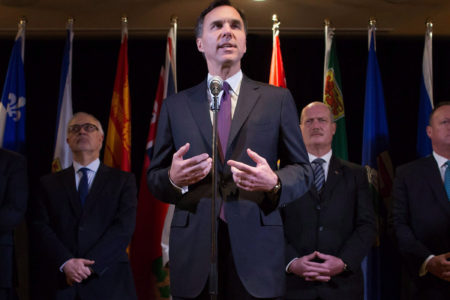
I’m so disappointed by your generation. All you seem to want out of life is a safe easy job with a good pension at the end. We fought for more than that.
Colin Cameron, 1968
The embarrassing mess that was the collapse of Nortel was replete with irony and hypocrisy. None was more bitter than the revelation that, as the company slid into bankruptcy, those at the top paid themselves more in bonuses than it would have cost to save the employees’ pension and severance plans. Such an abuse of the corporate and shareholders’ assets to reward the very executives who had led the company into ruin seemed to cap a decade of disappointment over the fate of private pension plans.
There was a golden era of post-war private pensions, when large employers were rewarded with tax concessions to encourage them, with their employees, to jointly fund defined benefit plans. It already seems as misty a part of history as stable lifetime employment, martinis at lunch and smoke-filled cafeterias. The collapse in the number of Canadians entitled to a guarantee of some income security in their dotage has been astonishingly fast and steep. Today fewer than one in four private-sector employees have a pension plan, versus nearly nine out of ten in the public sector. RRSPs are so far a limited solution to the emerging gap with less than a third of Canadians making any contribution to a plan, and only 7 percent of Canadians actually using their full contribution room. As a variety of experts have attested, a large chunk of the baby-boom generation is on the verge of retirement with only the state to depend on for a retirement period that will be, on average, the longest in Canadian history.
I was hurt and bewildered at my grandfather Colin Cameron’s explosion of frustration at my peers’ allegedly shallow ambitions and sense of entitlement. I was still at the delusional stage of youth that imagined revolutionary horizons for my generation. Colin was among the Canadian pioneers of the fight over 50 years to win first employer-funded and then public pensions. As a Great War veteran, however, he could never equate his generation’s appalling sacrifice with a search for the mere achievement of material comfort. How much angrier he would be today at the sight of stolen private pensions, alongside a public sector vigorously defending its gold-plated income security, unabashed at the collapse of retirement dreams for all those who pay them to serve.
There was a time when a guaranteed annual income seemed just around the corner. The Trudeau government, along with many others, tinkered with various approaches up to the oil price crash in the 1970s. That was a time when most governments thought they had solved the issue of pension financing and unemployment insurance schemes were being enriched and expanded. How innocent and long ago those times seem now. Some form of negative income tax or lifetime income security still makes sense to many policy experts, set against the inefficiencies of a welter of competing social security schemes. Today’s fiscal crisis means nothing is likely to move on that front for the better part of this decade.
In Japan, savings rates began to slide by the late seventies from worldbeating levels, when the government announced plans to create the first national public pension program. They levelled off when the country collapsed into years of layoffs, Japan’s lost decades. In China, despite an unprecedented boom in personal incomes in this decade, there has not been any significant decline in that country’s savings rate. China is still the world savings leader at nearly 40 percent of income, an astonishing number. Part of the reason is that public-sector employment, public health care and retirement security have all declined for most Chinese citizens as a result of its move to a more market-oriented economy. In addition to this fear factor, there is a lack of financial instruments in which to invest savings.
In the United States, savings collapsed to near zero during the dot-com bubble, climbed slightly after that crash and then dipped to an unheardof below-zero rate in the real estate boom. Now Americans, facing the highest levels of unemployment in a generation, are on target to save more than 10 percent, a threshold not seen in decades. Again, anxiety over the long-term future of their underfunded social security system is no doubt a driver. Canadians, typically, follow the same cycle as Americans though usually later and more moderately. Our savings are climbing again after a long secular decline.
There was a golden era of post-war private pensions, when large employers were rewarded with tax concessions to encourage them, with their employees, to jointly fund defined benefit plans. It already seems as misty a part of history as stable lifetime employment, martinis at lunch and smoke-filled cafeterias.
Meanwhile, governments around the world are staggering under rapidly increasing costs for welfare, unemployment compensation and old age pension supplements and debt, at a time of sharply reduced tax revenues. The ballooning short-term deficits that these costs, along with massive pumppriming stimulus spending, are generating are worrying. More challenging are the mountains of new public debt being generated for an entire generation of future taxpayers. Japan is expected to owe more than two and a half times its annual GDP in national debt by the time we hit the current bottom, more than five times the “old normal” view of a prudent peacetime ceiling. As conservative economists like to observe, when rattling governments’ fiscal chains, “Today’s deficit is only a deferred tax tomorrow.”
What does all this upheaval portend? Among many other changes, it probably means the end of publicly funded pension systems capable of delivering dignity in old age for most citizens. The era that began with Bismarck’s first pensions in the 19th century and then peaked in the “golden decades” after the end of the Second World War — when governments across the developed world supervised economies growing fast enough to support large increases in social spending, and corporations willingly supported generous private pension plans — seems near to an end.
The corporate motive for supporting these systems, lest we forget, was less philanthropic and more a recognition that deferred payment plans — such as a guaranteed defined benefit pension plan — were excellent employee-retention tools. Plus they freed capital to spend today, under generous tax incentives, that might otherwise have had to be paid in current salaries. As commitment to longterm employment has slid, so has much of the logic for investing in private pensions by employers.
Governments’ share of total GDP is close to maxed out in many developed countries, often just under half of total income. Significantly broadening the tax-supported base of employment or retirement spending was probably not realistic for most governments, before the additional burden of the enormous new debt loads imposed by stimulus recovery spending. Today it seems completely improbable.
Corporations’ experience of the roller coaster of recent decades between pension surpluses and horrendous shortfalls has caused many to want to shift much of the retirement cost burden on to their employees and to the state — perhaps unwisely even in their own self-interest. Though private-sector pension experts can irrefutably demonstrate that the administrative costs and reduced scale of personally managed retirement savings plans are always less productive and more expensive than the old-fashioned kind, the lure of reducing future obligations has been irresistible for employers.
Governments, too, have been foolish in believing that a combination of tax incentives and exhortation could persuade enough citizens to save sufficiently for the final third of their lives out of their current income. For many, the idea of putting aside that many dollars out of their disposable income is simply a cruel joke. Even for those who could save a great deal more the competing signals in our consumptionled society drag many of those dollars to bigger houses, cars and lifestyles.
The projections in Canada and the United States are brutal. Actuaries groan at the gap between the actual savings of the boomer generation, their likely lifespans, and their lifestyle expectations. Given the political power dictated by boomer numbers, it will be hard for governments to survive a deliberate impoverishment of the boomers or to punish the “grasshopper” irresponsibility of many of them. There is little political will to further impoverish the public treasuries to fill that gap, however. A political crisis in the next decade looms.
But the really poisonous ingredient in this wretched stew is the increase in white-collar job insecurity. Employee-retention schemes make sense to employers when there is a real competition for scarce skilled labour. They don’t make any sense if you can function with an oscillating number of mostly contract employees. They are simply suicidal if you know that you will face unavoidable layoffs as well as hiring needs in the same business cycle. With the exception of wars and the Great Depression, today is the first time in more than a century in which highly educated, professional employees have little prospect of job security. This spread of employment anxiety is going to have a huge impact on our politics and our national fiscal debates.
Savings for retirement make sense, until, that is, you get laid off and are forced to replace lost income by dipping into those savings. Some are surviving this crunching recession and even saving a larger slice of their now smaller income. Many more cannot and are reaching into RRSPs and piling on credit-card debt to survive. Those who have managed to save will probably need to work many years longer to replace lost investment income. The indebted, many of them middle-class families, face longer and gloomier prospects.
In the United States savings collapsed to near zero during the dot-com bubble, climbed slightly after that crash and then dipped to an unheard of below-zero rate in the real estate boom. Now Americans, facing the highest levels of unemployment in a generation, are on target to save more than 10 percent, a threshold not seen in decades. Again, anxiety over the long-term future of their under funded Social Security system is no doubt a driver. Canadians, typically, follow the same cycle as Americans though usually later and more moderately. Our savings are climbing again after a long secular decline.
The battle over employment insurance eligibility last year was a connected issue. It was partly a product of the shift in who is vulnerable and where they live. It was not a big deal for most Canadians and their governments to extend generous benefits to unemployed fishermen and forestry workers. They were not so numerous and the amounts involved were manageable. When you are talking about supporting nearly half a million Canadians who have lost high-paying jobs in the manufacturing sector in the past decade the odds and the numbers get more problematic. When you add a group as iconic as thousands of previously highly paid Nortel employees, the issue becomes politically toxic.
Although layoffs in both resource industries and manufacturing have long been a feature of both sectors, it is the apparent increase in the frequency and level of volatility there and across the private-sector service economy that appears to have spooked both politicians and voters this time. The young telecom engineers who escaped the dot com bust only to be hammered by this crash now face their forties with no job, paltry if any savings and young families. Not surprisingly, they’re angry. The financial-services-sector employee, seduced by the appearance of unstoppable growth and chunky annual bonuses, may not be an obviously sympathetic jobless victim — but their fear of income insecurity today and into the future is no less real or politically powerful.
Old-timers can sneer that when they grew up unemployment was often twice as high, and benefits were much lower and more short-lived. They can remind us that in the 1970s and 1980s interest rates never got below the teens, imposing huge burdens on household borrowers. They might be forgiven for shouting “Stop whining” at those who are struggling today.
There are two problems with this response: it takes no account of, let alone responsibility for, the enormous burden of debt which that generation has now bequeathed to its own children, nor of the burden they themselves will probably become as they age for their own families. Secondly, it’s not relevant politically.
The politics of income insecurity are driven by the perceptions of accountability and blame by today’s voters. It is the power of their anger at their having to accept such diminished expectations, and who they want to punish for that reality, that will drive public decision-makers. Neither claims of future relief nor comparisons to a more painful past are likely to get many finance ministers through the bitter budget debates most will face in the decade ahead.
Some countries faced these crises earlier and there are lessons in their experience. There are no models that could be imported as a whole, but they have features that we desperately lack. They require significant personal contribution, and they are compulsory. They insist that you participate with government and your employer in your lifetime income security and in your retirementincome planning. Currently, Canadians are required to contribute an almost trivial sum to their own retirement through CPP deductions.
In Chile, a controversial scheme, based mostly on private-sector investment and compulsory individual contribution, has created a unique approach to both unemployment insurance and pensions. Critics say that market volatility, administrative costs and inadequate contribution levels mean it is doomed to failure over time. Supporters point to the already visible impact it has had in poverty alleviation. Two decades of centre-left government have pulled an unheard of number of Chileans out of poverty, using a mix of publicand private-sector investment and taxation tools. Chile’s new centreright president has pledged to maintain their unique system.
Australia instituted a compulsory form of retirement savings plan more than a decade ago and has tinkered with employers’ and government’s responsibility to top it up several times. The scheme is similar to American Social Security or the Canada Pension Plan in coverage and reach, but it differs dramatically in the amounts that individuals are expected to contribute and how the money is managed. However, its requirement that everyone save for their own retirement, a sort of compulsory RRSP, has placed most Australians on a much safer footing for security in old age than ever before.
Singapore extracts as much as one out of every five income dollars earned from its citizens and uses the money for both economic development projects and to fund retirement. Some of the uses of Singaporeans’ savings have wasted millions and raised eyebrows, but on balance the scheme is popular and seems to be actuarially sound. It is the product of a semi-democratic government’s ability to impose a tough savings scheme on its citizenry, not easily emulated here or elsewhere in the developed world. No Singaporean will face the indignity of declining health and poverty in old age, however.
Hong Kong’s Mandatory Provident Fund set up a decade ago, shortly after the community’s handover to China, is another variation on this theme. Privately sold and managed investment schemes, tightly regulated and supervised by a public overseer, compete for employers’ and employees’ favour. Everyone is compelled to buy into one of the approved schemes and so far the returns set against costs are promising. Hong Kong’s case is probably not replicable either, as it has so far profited enormously from its access to the booming China economy, a growth model not available to Canada’s future retirees.
However, it too requires employer and employee to each contribute 5 percent of gross income, a provision common to most of the schemes that are solvent and well-reviewed by international experts.
Most of these countries have less generous employment-income protection schemes than Canada or Europe. The combination of employment insurance that grants livable benefits for extended periods, in tandem with a pension system doing the same at the end of one’s employed life, is the hard nut to crack in today’s volatile economies. But little of the current thinking in this field is a replication of the rosy vision of a middle-class life supported by a guaranteed annual income, secured through tax revenue and employer contributions alone. That was the conventional wisdom among most experts only a few years ago.
Two lessons of those countries’ experience seem relevant to ours: everyone must contribute from their own incomes for their entire working lifetime, and those contribution levels need to be much higher than we have become used to. This combination of compulsory savings at perhaps double our existing savings rate will be a very tough sell for politicians anywhere. Not only is there the resentment at government enforcing a change in the freedom of choice about spending, for all of its citizens for their entire lives, there is also the issue of intergenerational equity or fairness.
As a headhunter for a global American technology firm in the 1990s, I was astonished to be greeted with an absolute refusal to pay Social Security contributions by a young executive about to be hired. The issue was not money but credibility and trust. This young woman, whose income would approach half a million dollars a year, balked at paying a less than 2 percent of that toward her own retirement. I was baffled. She regarded me as a credulous fool for my assertion that at a minimum it was a good investment for the future. “There is no bloody way that I am ever going to see any of that money,” she responded angrily. “It will go to support your retirement and then it will collapse and I will be left with nothing!”
I was patronizing about her naïve cynicism 15 years ago: I’m not sure that I would be so today. The level of political muscle and the leadership required to make the sorts of changes the Americans now require to fund Social Security are rare. I have often mused about that young techie’s predictions in the ensuing years and wondered who was more naïve. After all, George W. Bush at the height of his second-term mandate ould not push through changes in the American Social Security system. Will Barack Obama have enough political capital left, following his mauling in the health-care reform fight, to tackle what the Americans call “social entitlements”?
Liberal critics damned Bush for his suggestion that their system should incorporate both a private component and increased personal responsibility. They saw his defeat as a rejection of a “privatized pension system.” Now it is Obama’s turn to wrestle with Social Security reform. Recently he signalled an intention to investigate a publicly supported national annuity scheme. We shall see if those critics’ claims that it was the content of the Bush reforms that led to their summary rejection were valid, or whether it is really the pain that any type of serious reform will require that makes it politically undoable.
Here in Canada, the pension debate has achieved a profile it has not had in decades. The provinces and Ottawa are wrestling with amendments to the public systems. The NDP and the Liberals are wrestling with each other over whose ideas for pension reform have more credibility. Academic experts such as Monica Townson and Jack Mintz have issued research papers and recommendations for change. The Ontario NDP’s new leader Andrea Horwath won surprisingly positive reaction to her detailed proposals for a version of the Australian plan. In its initial rollout, Horwath said everyone in Ontario would be automatically enrolled — a euphemism for compulsory contribution — but would have an option to opt out and in again.
In the previous iteration of the retirement funding crisis — public-sector pensions — in the 1990s, Canada mostly got it right. In the view of most experts, turning over the pensions of teachers, public employees and even the CPP to professional fund managers worked. The ensuing decade has seen a return to near solvency for most of the big pension funds as a result of good professional investment leadership.
Now we have a new crisis. The looming reality is that neither public nor private pensions alone will be adequate to meet the needs of a generation about to retire. It is time to step up to some hard decisions on the part of Canadian governments and employers once again. Every Canadian needs to be making more of a contribution to their retirement security, and that can no longer be optional.
Photo: Shutterstock








